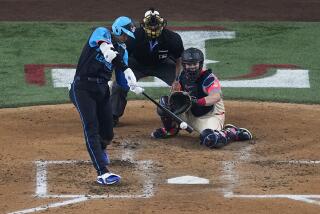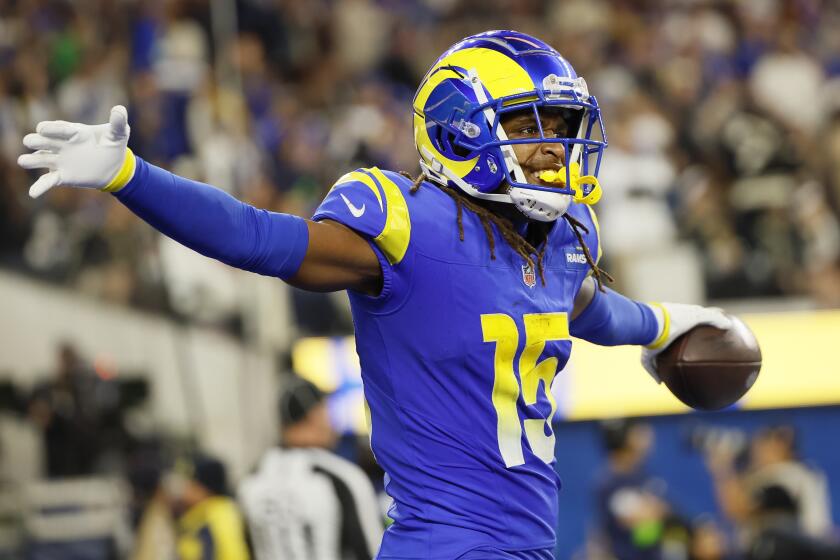Baseball’s Big Parade Back Again
MINNEAPOLIS — Minneapolis again. America’s icebox. The city that came in from the cold. Gateway to the North Pole. Minnie-no-place. The land that was settled by a slow leak in Scandinavia. A phone book with 14 pages of Olsons. Or Johnsons.
The stadium is domed. The rest of the state should be. The visitor who arrives is told that he just missed summer. It was last Friday. Morning.
There is a wholesome quality about Minneapolis. It is as modern as a silicon chip, but you get the feeling that you have stepped through a time warp and it is early 1900. Disney would love Minneapolis. It is as old-fashioned as homemade bread, as Old Worldly as a schottische.
It is putting its best foot forward because it is the host city for the major league baseball All-Star game, for the second time in its history, and it treats the event like company coming for dinner or a family picnic.
There are gratis airport pickups for baseball dignitaries and media types. It appears thrilled to be the focus of the “Today Show” and “Meet the Press,” and to have the chance to shuck on national TV its well-worn image of the city that comes into focus in a fur hat and snowshoes whipping a team of dogs.
Baseball is flattered--until it realizes Minneapolis is being arch. The city actually is bent on making a good impression in the hopes it can bag a really big event, the one it wants, the Super Bowl. That’s the show it covets. This is dating a girl so you can really woo her sister.
The city attracted more than 46,000 people Monday to watch batting practice. It would seem either there’s very little to do in Minneapolis between snowstorms, or these people are crazy about foul tips. Forty-six thousand would have been a good season for the old St. Louis Browns.
An All-Star game is not really a game, anyway, it’s more like a parade. The results don’t count in the standings, the hits don’t count in the stats. The pitchers only pitch about 30 pitches or three innings, whichever comes first. The gamblers don’t really post a line on the game, and to consider it a contest is a little like considering Shakespeare’s Hamlet a contest.
It is a recital is what it is, a selection of solos by the outstanding artists of our day.
Still, baseball being baseball, it goes into the lore of the game as resolutely as any World Series, playoff or pennant fight.
It began when Babe Ruth hit a home run to win the first one. You couldn’t write an Act One any better than that.
In the second one, there was a pitching performance so extraordinary, it completely obscured not only the game but every other achievement pitcher Carl Hubbell ever achieved. In that game, Hubbell struck out almost an entire wing of the Hall of Fame in a row--Ruth, Lou Gehrig, Jimmie
Foxx, Al Simmons and Joe Cronin.
Into the romance of baseball went the legend of how Gehrig came back to the dugout after his turn to confide in disgust to teammates: “You might as well swing, it ain’t gonna get any higher.”
Hubbell had World Series triumphs, no-hit games and shutouts, but he made the Hall of Fame that day on 17 or so pitches that otherwise didn’t count.
The 1937 game was a tragedians’ part, a body blow to all baseball. And the part of the body was Dizzy Dean’s big toe.
Cleveland’s Earl Averill smashed a line drive off the great Dean’s toe in that one and ruined more than a toe. He ruined a career. Dean, favoring the wounded digit, would never again throw a Dizzy Dean fastball, only a tentative facsimile thereof, and would be out of baseball within two years. Hard luck was never far from the All-Star histories.
In l941, for instance, a player named Arky Vaughan, one of the most underrated in major league history, hit two successive two-run homers for the National League in successive innings, the seventh and eighth, for an apparent National League victory. Then Ted Williams come up with two outs in the bottom of the ninth and his team trailing by a run, and hit a three-run homer for the victory.
Vaughan, who never did get elected to Cooperstown by the writers but later was selected by the Veterans Committee, dated his being overlooked from that incident. Williams shattered his limelight.
Williams himself didn’t escape the All-Star hex even though the game was essentially his stage. Ted was to the All-Star Game what Barrymore was to “Hamlet.”
In 1946, he walloped two home runs, the second off an “eephus” pitch, the baseball equivalent of a soap bubble thrown up by Pitcher Rip Sewell.
But, in l950, Williams crashed into a wall in the first inning of the game in Chicago, flagging a line drive off the bat of Ralph Kiner. Although he stayed in the game--he went 1 for 4 and drove in a run--he learned that he had broken his elbow in the collision and was out the rest of the season, a serious statistical setback to a man who also gave up four years to military service.
In hockey, basketball or even football, an All-Star game is usually a meaningless exercise in forgettable posturings. No anecdotes recall past glories or mishaps, or turns of fate.
But in baseball, it weaves itself into the fabric of the game. It may not determine pennants but it determines careers. In its own way, it proves again the Grantland Rice adage, “It’s not whether you win or lose, but how you play the game.”
More to Read
Go beyond the scoreboard
Get the latest on L.A.'s teams in the daily Sports Report newsletter.
You may occasionally receive promotional content from the Los Angeles Times.










